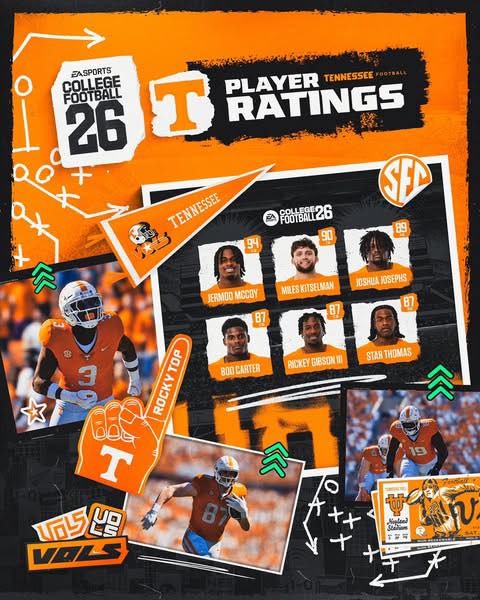EA SPORTS’ return to the college gridiron with College Football 25 has sparked a tidal wave of excitement—and controversy—among fans, analysts, and players alike. For the Tennessee Volunteers, the unveiling of their in-game ratings has been a polarizing moment. The Vols emerged with both standout individual performances and an overall team score that has fueled debate across Rocky Top and beyond. Here’s an in-depth exploration of where Tennessee landed, why some fell short of expectations, and what it all means for virtual fandom.
Tennessee’s collective identity in College Football 25 is captured in their overall team rating: 85. This is complemented by an offensive score of 83 and a defensive score of 80, placing them at No. 15 in the national rankings out of over a hundred teams (. Considering an explosive 2023 season—highlighted by a dominant offense and a second consecutive 10-win campaign—many expected higher marks. Instead, the Vols found themselves slightly under-rated in the eyes of EA Sports compared to their on-field pedigree.
That sentiment crystallized in coverage from SI.com, which noted Tennessee was left out of both the EA CFB top-25 offensive and defensive units rankings—a perceived neglect for a team fresh off top-3 finishes in total offense within the SEC ). Further stirring the pot, On3 reported Neyland Stadium as the No. 13 toughest home environment—acknowledgement for atmosphere, if not on-field talent (.
Major momentum arrives from standout performances by Volunteers earning stellar individual ratings. Defensive end James Pearce Jr. claims the crown, seen as one of the top four players overall in the entire game at 95 overall . Boasting a lethal combination of 88 speed, 85 strength, 89 agility, and 95 acceleration, this elite rating mirrors his real-world impact—10 sacks, 14.5 tackles for loss, and peerless disruption during the 2023 campaign
Another anchor on the offensive line, center Cooper (sometimes referenced as Cade, Cooper Mays) Mays, secures a commendable 89 overall rating—fueled by a perfect 95 awareness, 87 strength, and 80 acceleration. After missing time in 2023 due to hernia surgery, he reestablished himself as Tennessee’s linchpin .
The receiving corps includes a pair of explosive playmakers. Squirrel White registers an 87 overall, leading the squad in speed—95 maxed out, coupled with 91 acceleration and 87 agility . Meanwhile, Bru McCoy checks in at 86 overall, his mark a testament to quickness (91 ratings in acceleration and awareness) and reliable hands returning from injury (.
Guiding them all is freshman quarterback Nico Iamaleava, also rated 86 overall, a spot shared with McCoy. The young signal-caller burst onto the stage with three rushing touchdowns in the Citrus Bowl, and carries NCAA momentum into the virtual realm . The optics surrounding his rating—86 as a Heisman-hyped prospect—sparked deeper discussions, placing him at No. 24 among quarterbacks nationally in the game .
Rounding out the 80-plus club are several high-impact contributors: running back Dylan Sampson at 85 overall, defensive tackle Omari Thomas at 83, and wideout Chris Brazzell II at 82 . A robust supporting cast—spanning Dont’e Thornton Jr., Jourdan Thomas, Javontez Spraggins, Holden Staes, Jackson Lampley, Bryson Eason, and Dominic Bailey—fills out as 80 or 81-rated pieces
Looking beyond the top-tier players, Tennessee suffers no shortage of talent in the mid‑70s. A significant stable of juniors and sophomores—ranging from CB Rickey Gibson III to TE Charlie Browder—adds considerable depth across all units .
Speed emerges as another real-world asset mirrored in the game. According to USA Today coverage by On3, Peyton Lewis (RB) tops Tennessee with 97 speed, followed by Squirrel White and Dylan Sampson at 95, and a slew of receivers and ball-carriers in the 93–94 range . Strength ratings are also realigned: interior defensive linemen like Omari Thomas and Elijah Simmons boast 94 strength, and linemen across the board sit between 90–93 strength .
Yet the compressed scale of EA’s rating system has sparked fan frustration. Across discussions on Reddit and fan forums, many argue that Tennessee’s overall score is deceptively low given their explosiveness—a reflection of EA’s approach to compress ratings within a bell curve around the 70–90 range . One fan lamented: “The Tennessee disrespect is CRAZY,” underscoring the gulf between expectation and in-game assessment .
In response, analysts speculate that EA’s formula weights factors like team depth, special teams, and prestige in ways that obscure pure talent. Some posit that Tennessee’s quarterback uncertainty with Iamaleava and a lack of truly dominant linemen may have tilted the overall scores more so than their offensive output suggests .
Yet context matters. The SEC remains home to elite competition—Georgia leads the conference at 95 overall, with Alabama (92) and Texas (91) not far behind . Tennessee’s 831“As of NCAA 14 Notre Dame was sixth best with 93 overall” is emblematic of a league in which even a strong team can appear middling in comparison .
Bear in mind this snapshot reflects the game’s state at release. Despite calls for mid-season updates, EA has signaled that College Football 25 will remain static post-launch—meaning these ratings already represent the definitive Vols experience in-gam.
So what does this all mean for Tennessee fans hoping to dominate on the digital field? For starters, James Pearce Jr. stands as a generational force—95 overall speaks to his virtual ability to change games. Offensive line prowess through Mays and versatile playmakers like White and McCoy provide potent offensive versatility.
The offense should click right out of the gate, featuring elite pass-rush threats, a quick-strike aerial game, and a power-running ground attack with Lewis and Sampson. Defensively, though outside stars shine, the unit as a whole is rated 80—suggesting challenges against stronger in‑game opponents and potential vulnerability in the middle tiers.
College Football 25 reflects a Tennessee team that is deeply talented at the top and structurally solid, but perhaps not pegged yet to reach elite heights—at least in EA’s internal calculus. The Vols’ virtual portrayal rewards star power and athleticism, but underestimates team cohesion, heritage, and potential upside.
Ultimately, the ratings spark an ongoing conversation: does EA’s model capture reality or distort it? From Pearce’s 95 to Neyland’s top‑15 toughness, the highs are unmistakable. But the absence from top‑25 unit rankings and compressed bell‑curve methodology leave some fans cold.
Still, the upside looms largest. For Vols faithful diving into College Football 25, Tennessee remains a playable, competitive program with superstar talent, speed, and identity. Those willing to push the limits of the scheme can harness Pearce’s disruption, lean on Mays’ line dominance, and roll out an offense built on explosiveness.
Whether the game’s narrative aligns with what fans witnessed in real life, one thing is undeniable: Tennessee Volunteers in EA SPORTS College Football 25 represents a tantalizing starting point. With a roster of high-caliber athletes and a framework built for success, the real test will be how users unleash that corner raid, pinpoint the passing game, and grind out yardage behind a composed offensive line.
In the end, EA’s ratings offer a numerical baseline—but it’s up to gamers, fans, and coaches in the virtual world to elevate Tennessee from merely rightfully rated to downright dominant.



